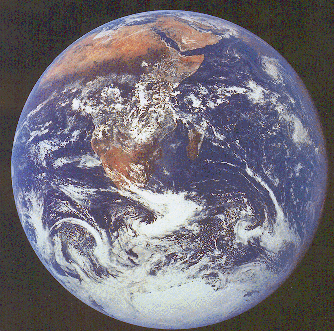Deserts of the World

LE
FastCounter
 |
Earth from Apollo 8
This photograph shows the continent of Africa and the Arabian Peninsula. The Sahara, Kalahari, and Arabian deserts (as well as southwestern Madagascar) are clearly visible as brown-colored areas. Clouds cover much of
central Africa. The dark band immediately to the south of the Sahara is known as the Sahel, the Arabic word for "shore." When Arab merchants and soldiers arrived in North Africa around 650 a.d., shortly after the Islamicization of Arabia, they
became aware that the Sahara's southern boundary advanced and receded like oceanic tides.
|
Deserts are
Dry
In what way are Antarctica and the Sahara
similar? Both can be called "deserts." Desert climates are dry, but a lack of precipitation is not the end of the story. For a region to be a desert, the annual potential evaporation
must be greater than the annual precipitation. In fact, it is better to
refer to deserts as drylands. The drylands of the
world can
be
classified along
a continuum ranging from subhumid to hyperarid, as the figure below
shows.
Half the countries on earth lie partly or entirely in the arid
and semiarid zones, which cover one-third of the planet's land surface, 44
percent when the subhumid zone is included. In 1950, the population of
these countries was 76 million; in 1985, population reached 205 million.
The forecast for 2000 is for 300 million people to be living on the
Earth's drylands.

The correct citation
for this chart is:
Milich, L., 1997. Deserts of the world.
http://ag.arizona.edu/~lmilich/desert1.html.
 Select a
desert
Select a
desert
 Desert Locator Maps with Climate Classifications
Desert Locator Maps with Climate Classifications
 Desert geomorphology
Desert geomorphology
 Cryptic Life
Cryptic Life
This site
last updated October 30, 1998.


 Select a
desert
Select a
desert